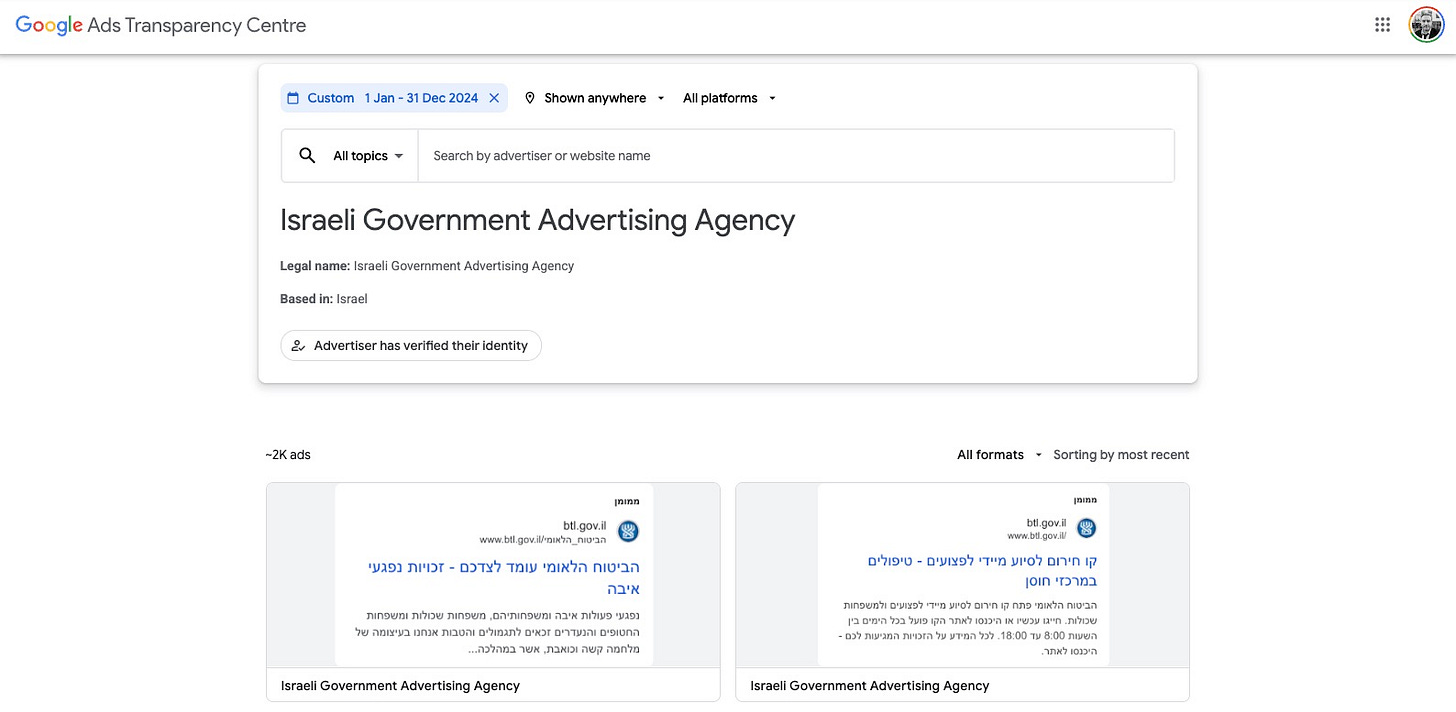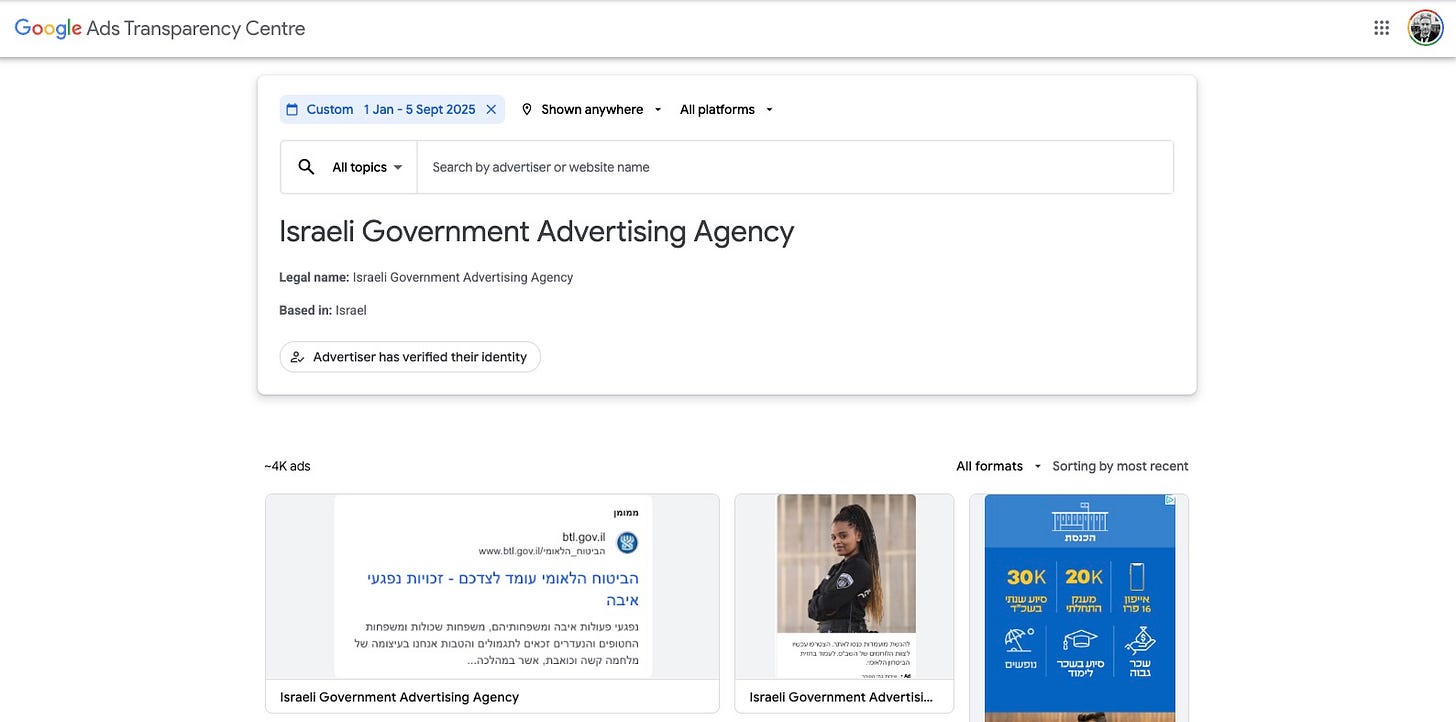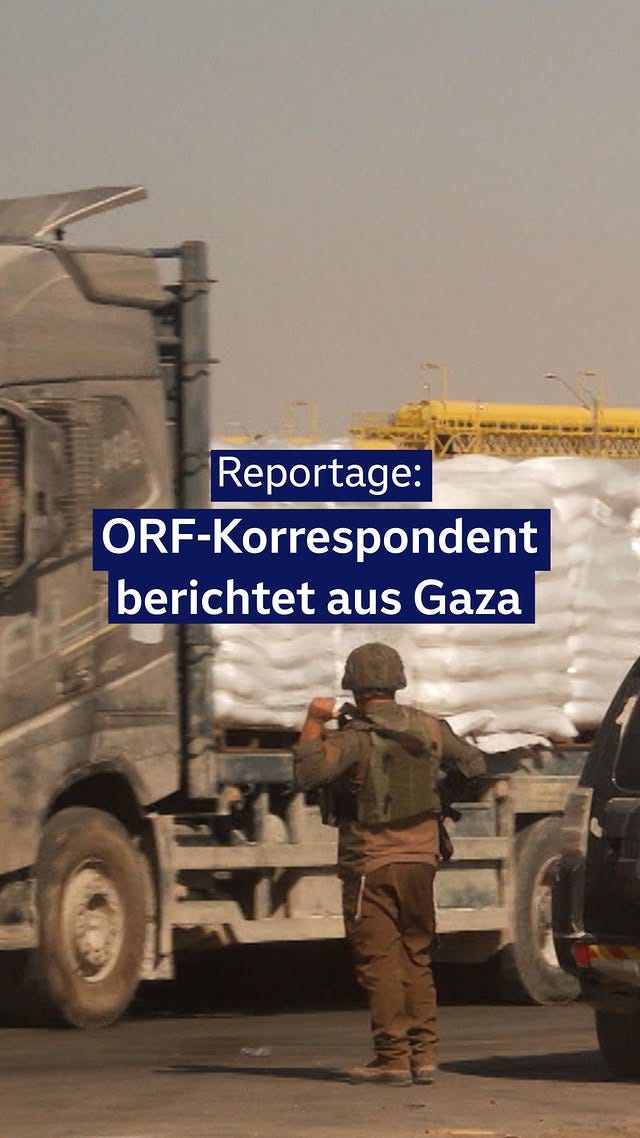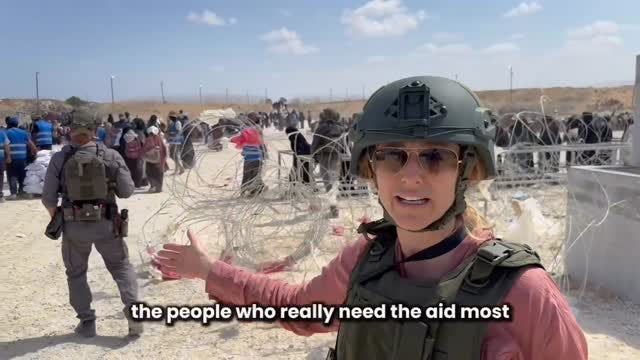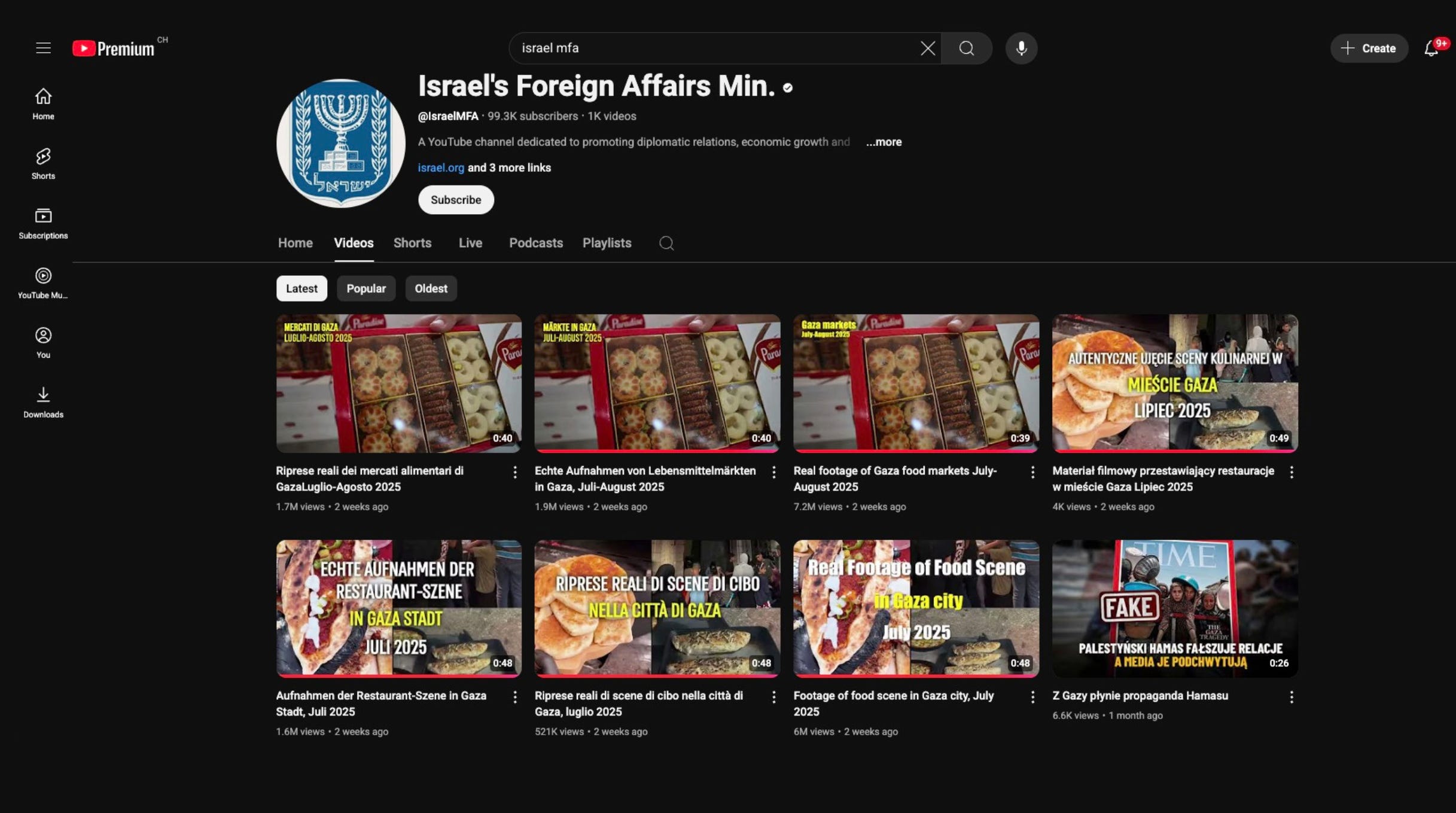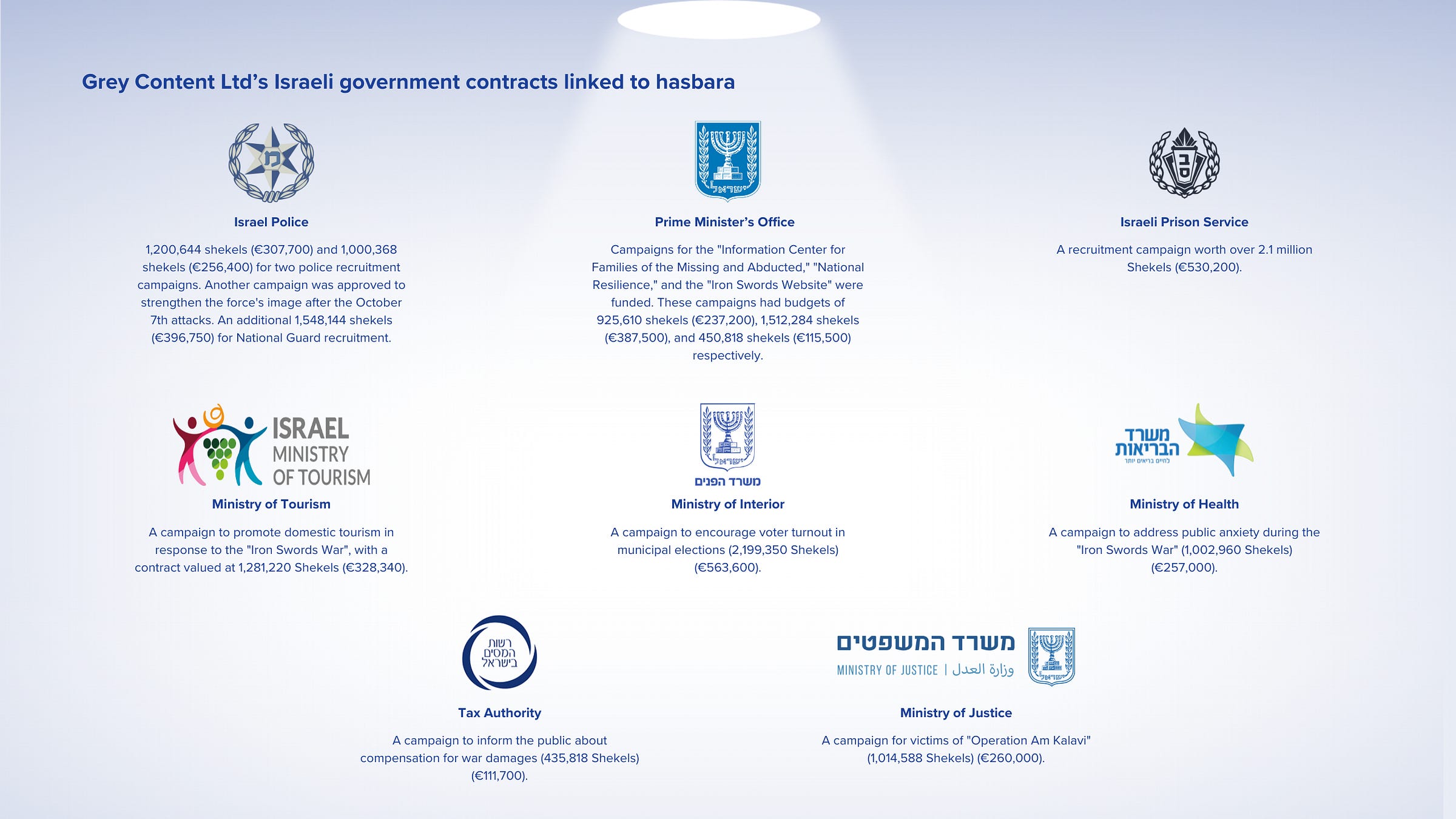The new front of war: Inside Israel's digital 'hasbara' offensive
Documents reveal how Israel's state-sponsored 'hasbara' campaigns use social media, paid influencers, and military tours to shape the global narrative on Gaza and counter critics
The modern battlefield for the State of Israel isn't confined to its physical boundaries; it extends to the screens and social media feeds of a global audience. An open source investigation of Israeli government advisories, committee minutes, and procurement documents by members of Eurovision News Spotlight reveals a sophisticated, well-funded, and often unconventional public relations strategy. This effort, known as hasbara or public diplomacy, is specifically aimed at shaping the international narrative around the country’s military operations.
These documents, spanning from 2018 to as recently as July 2025, detail a systematic effort by the Prime Minister’s Office and other Israeli government ministries to harness major digital and television platforms to counter what they perceive as a “hostile media environment.” The core of this operation is a centralised, agile, and at times, opaque procurement system that prioritises urgency and "special trust" over standard competitive bidding for government contracts.
At the centre of this online offensive is the Israeli Government Advertising Agency (IGAA), a state-run bureau known as Lapam, which is using the advertising platforms of Google and Meta to promote Israeli government narratives and counter those who directly challenge Tel Aviv's policies and military operations through paid advertising.
These campaigns rely on emotionally charged, debunked narratives that are meticulously planned and executed, such as paid-for ads showing bustling Gaza markets to counter reports of famine, campaigns labelling the UN Special Rapporteur as an “anti-Semite,” and advertisements that accuse the United Nations Relief and Works Agency for Palestinian Refugees (UNRWA) of being a "front for Hamas."
According to the Google Ads Transparency Center, in 2024, Lapam sponsored 2,000 ads, 900 of which were aimed at the domestic population, while 1,100 targeted international audiences in selected countries.
In contrast, from January 1 to September 5, 2025, Lapam had published more than 4,000 advertisements, 50% percent of which had been targeted at international audiences.
This report documents a strategic information operation that utilises government communication and wartime propaganda. The investigation reveals that the Israeli government's hasbara apparatus is not solely focused on presenting its perspective but on actively constructing a narrative to counter on-the-ground realities. This goal is achieved through a systematic network of contracts and a concentrated effort to influence the global conversation.
Part I: The tale of two Gazas
There are two distinct and competing realities of Gaza: the one presented by international reports, which documents a population suffering from famine, and the other, a manufactured narrative portrayed through government-sponsored media that shows a semblance of normalcy.
Famine was officially declared in Gaza Governorate in an August report by the Integrated Food Security Phase Classification (IPC), the world's leading hunger monitor backed by the United Nations.
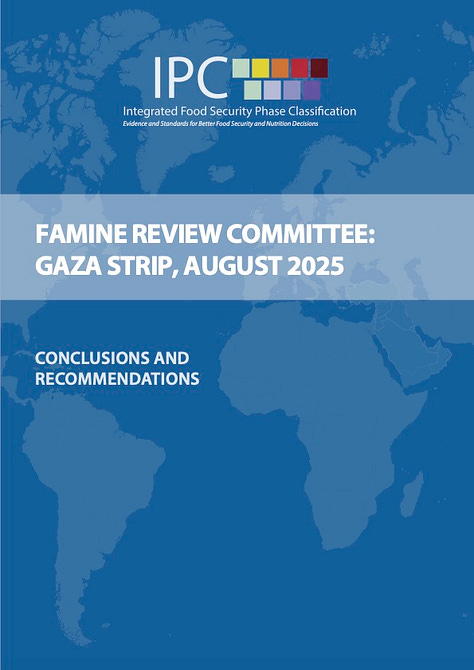
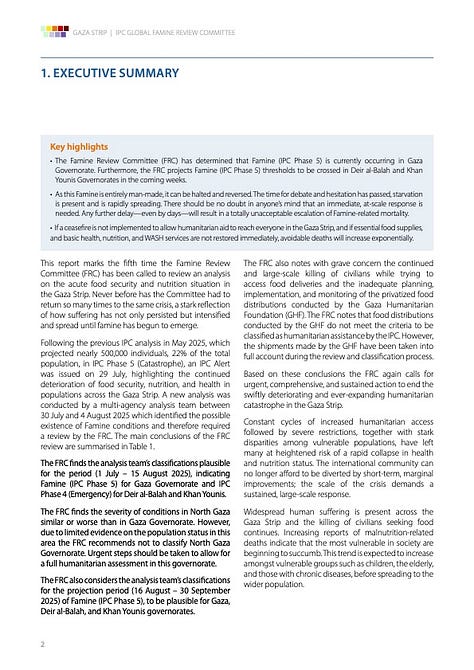
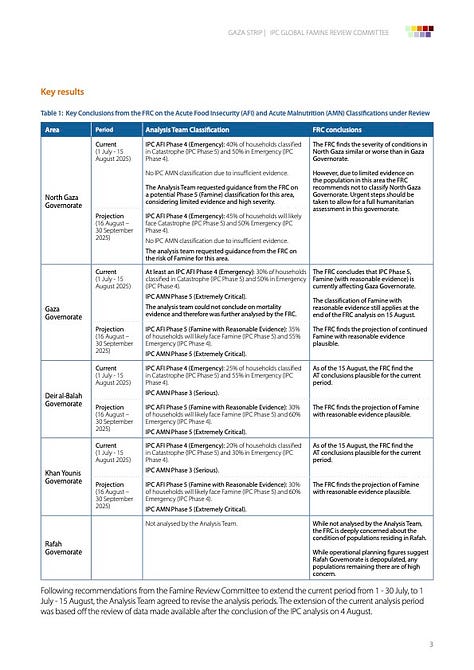
International reports and first-hand journalistic accounts describe a population suffering from the effects of a protracted conflict and a crippling blockade, which saw food, medicine, fuel, and other humanitarian supplies prevented from entering the territory since March.
Israel continues to refute the famine classification and the IPC report in its entirety, launching a government-sponsored media campaign portraying a semblance of normalcy within the besieged enclave.
Dozens of ads published by the Israeli state's advertising arm and placed across platforms like Google, YouTube, Teads/Outbrain, and X show bustling markets and restaurants in Gaza, intentionally creating a reality that conflicts with the IPC's findings, and promote a single message: "There is food in Gaza."
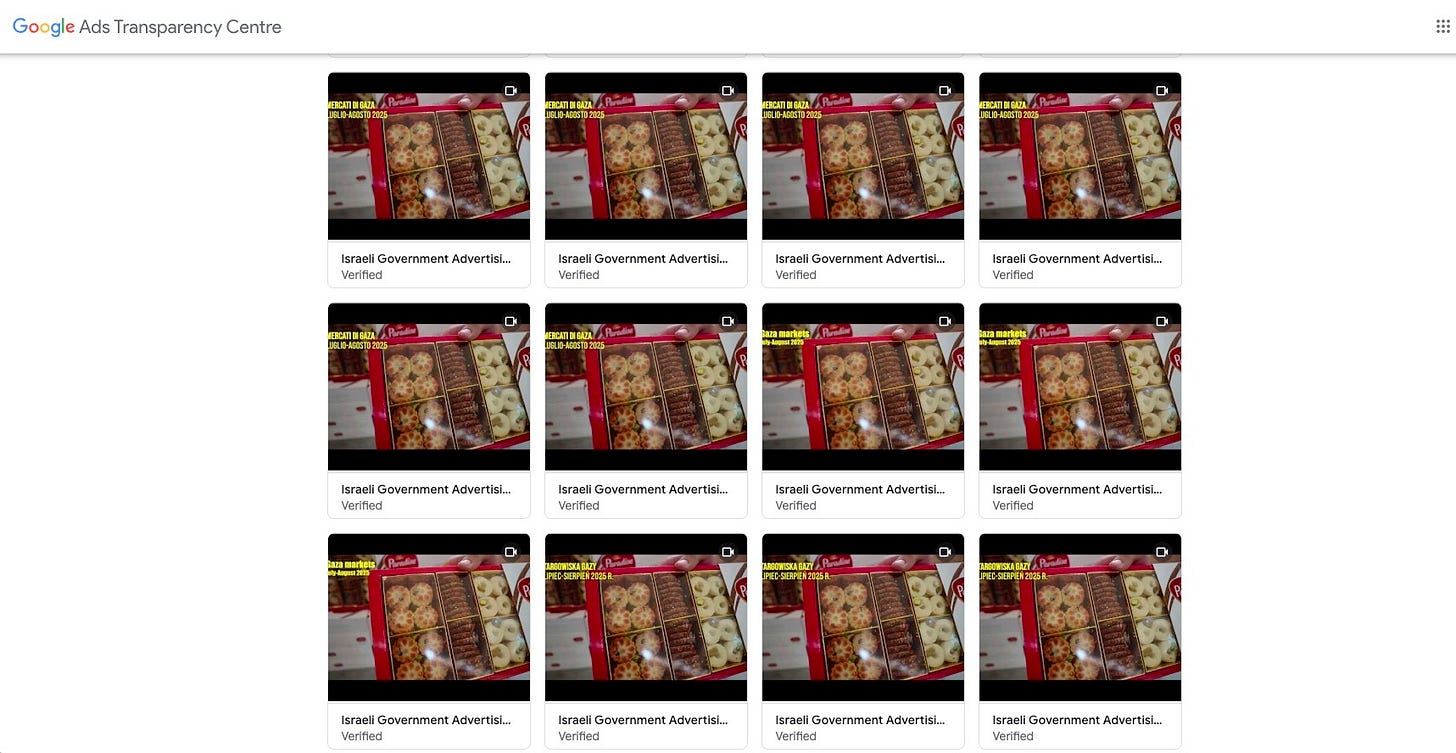
However, a closer examination of the reality on the ground, as reported by journalists, reveals the limitations of this narrative.
David Kriegleder, Israel correspondent for Austrian public service broadcaster Österreichische Rundfunk (ORF), said that he has repeatedly heard from contacts in Gaza that the food supply is much better in some areas like Rafah, Khan Younis, and Al-Mawasi, while supplies are much more limited in the northern areas, and that this is due to the aid supply mainly entering via southern border crossings.
The presence of food in certain markets says nothing about the overall situation, he said, adding: “The Gaza Strip is a patchwork when it comes to the supply situation, military escalation, and accessibility for aid trucks”.
“It's possible that four bakeries in Khan Younis have received flour and are making the finest pastries, while five kilometres away, nothing is getting through at all.”
Palestinian fact-checker Riham Abu Aita recently ran several in-person training courses in Gaza, and described high food prices and even an inability to find goods to feed to trainees, saying that “not all areas in Gaza are suffering the same”.
At the time of this report's publication, a Lapam-sponsored advertisement campaign encouraged readers to examine the "flaws and inconsistencies" in the IPC report that declared a famine in Gaza. This advertisement was strategically placed directly above the Google search results for the report itself, seemingly aiming to influence the first impression of users searching for information on the topic and direct them to an Israeli government website.
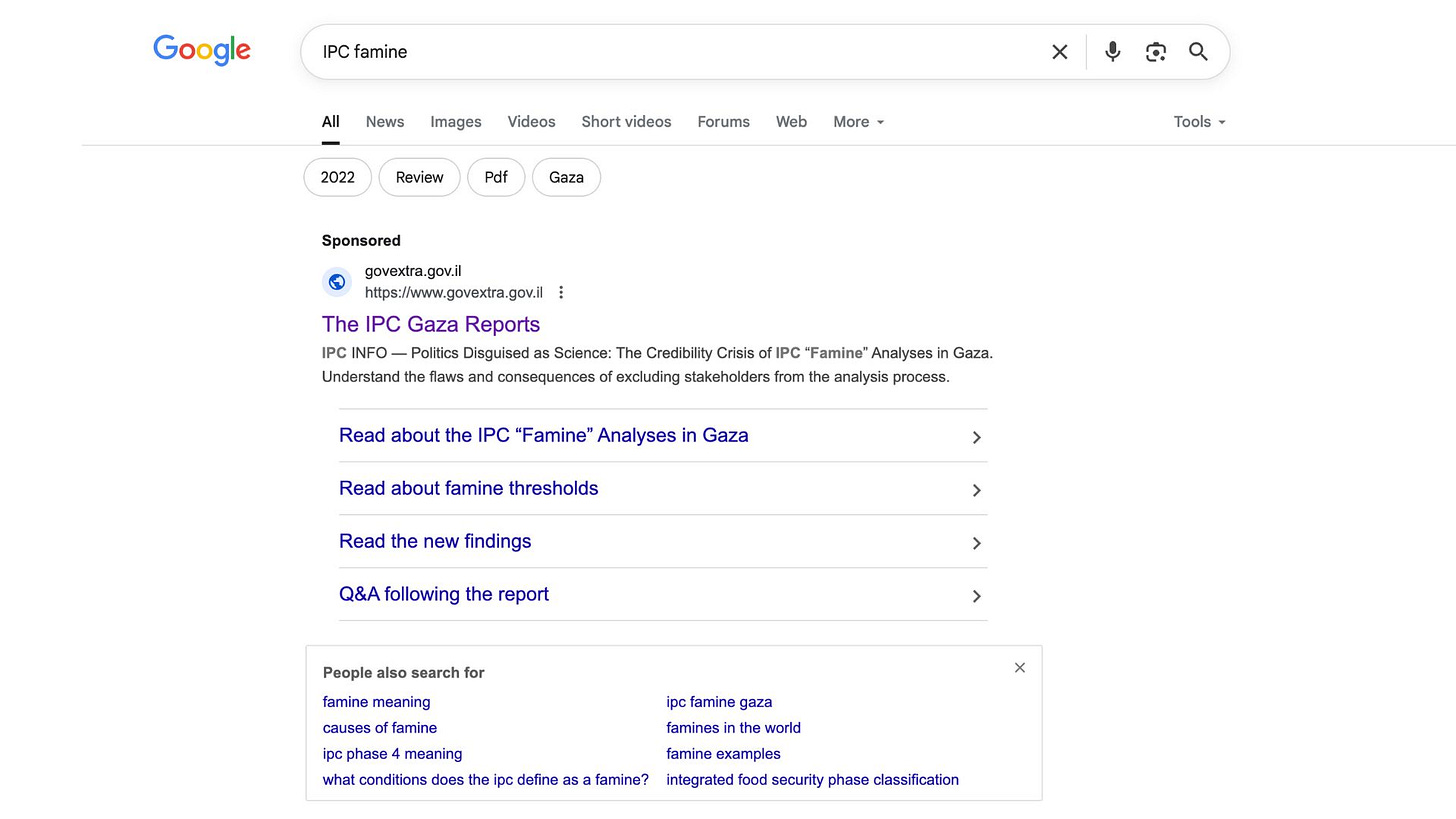
According to the Google Ad Transparency Center, this advertisement was visible across various European countries, including Belgium, the UK, Denmark, Sweden, and Germany.
When contacted for this report, the Israeli Ministry of Foreign Affairs responded via the country's embassy in Berlin and did not offer a new comment, but instead referred our reporters to two X posts by the Ministry.
The first described the IPC report as "fabricated ... to fit Hamas’s fake campaign".
The other, by ministry spokesperson Oren Marmorstein, referenced a resolution by the International Association of Genocide Scholars, which accused Israel of committing genocide in Gaza. Marmorstein said that it was "an embarrassment to the legal profession and to any academic standard" and added: "It is entirely based on Hamas’s campaign of lies and the laundering of those lies by others."
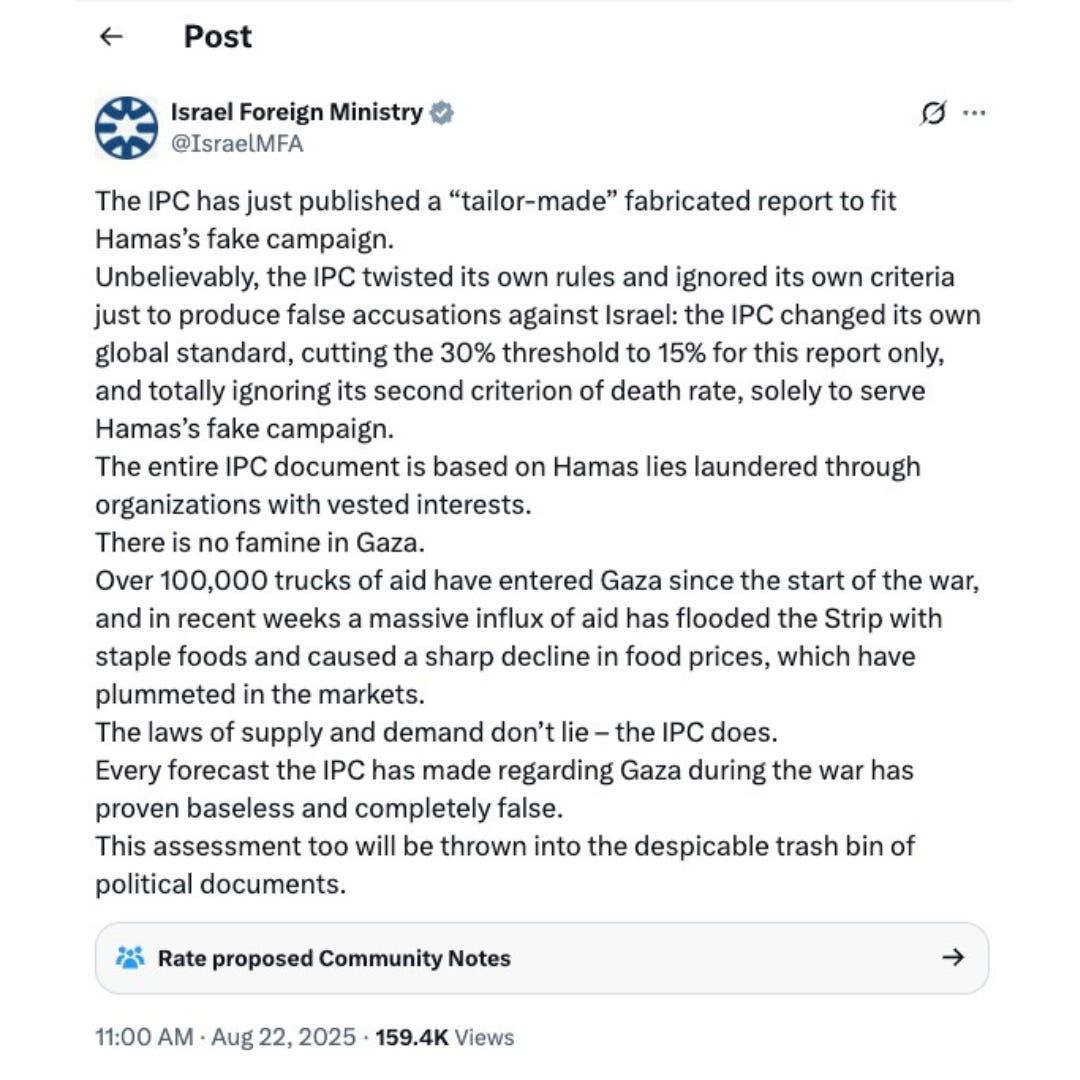
The embassy also attached a scanned letter which was sent by the Director General of the Ministry of Foreign Affairs to the IPC after the declaration of famine. It listed a series of claims referring to flaws in the research for famine classification.
In response to the letter, the IPC released a new document addressing the claims and defending the famine analysis. The IPC’s assessment of the situation in Gaza used a methodology that was previously used in Sudan in 2024 and South Sudan in 2020—a simplified data collection method that is explicitly permitted in war and crisis zones under IPC guidelines—and that standard was not changed or lowered for Gaza.
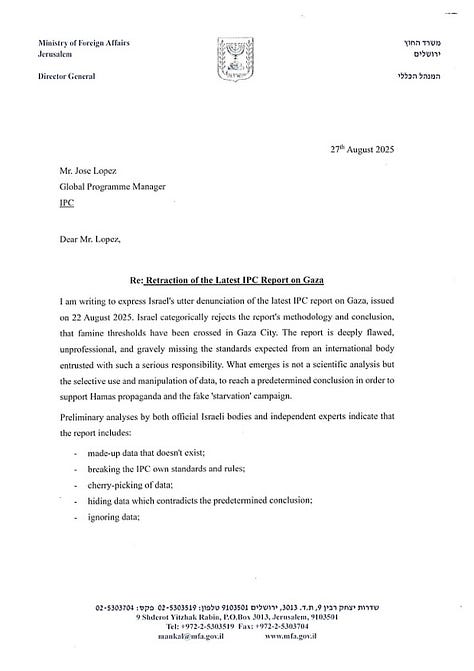
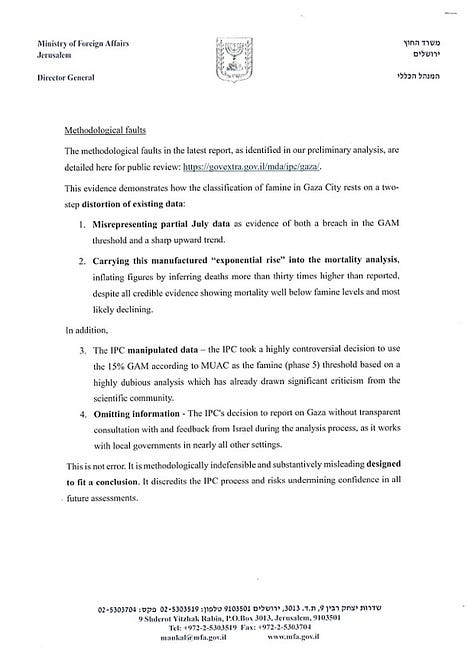
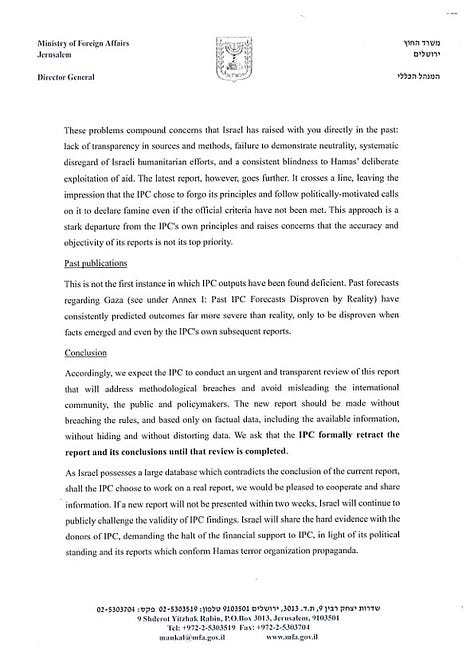

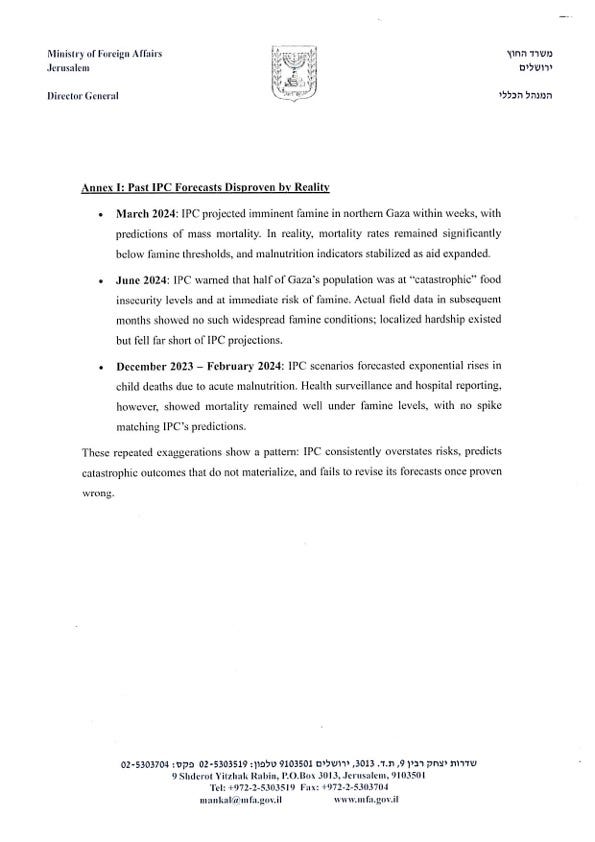
International journalists are banned from reporting independently from Gaza, with media tours offered by the Israeli military heavily controlled. The IDF-embedded tours inside Gaza, which has seen influencers and international journalists brought on visits to view specific sites mainly related to the aid work of Israel, are currently the only way international reporters can get inside Gaza. This is despite the world's largest media organisations and alliances—including the European Broadcasting Union—demanding that international reporters be allowed into the enclave to report freely on the conflict.
David Kriegleder described one such controlled media visit to a logistics hub in Gaza on August 21, while embedded with the Israeli army, which he characterised as a clear hasbara effort.
"The purpose of the visit was to show us that there were aid supplies stored there, that the Israeli army was allowing enough to enter, and that the problem was international aid organisations and the UN not picking them up in time. So, this was the 'hasbara' idea behind the trip," Kriegleder said.
He explained that the tour was carefully managed to promote a specific narrative—that Israel wasn't responsible for the humanitarian crisis—and to prevent journalists from seeing the full picture.
"We had been promised that we would drive up to 10 kilometres into Gaza and possibly visit one of the controversial GHF (Gaza Humanitarian Foundation) distribution points. That did not happen. We drove only about 6-7 minutes onto the Gaza side of Kerem Shalom, where there is a relatively large logistics hub. We were then taken to a storage area, or more accurately, an expanded parking lot," he said.
The UN contends that the primary reason aid supplies are not being distributed is not a lack of effort on its part, but a severe bottleneck at the border. The number of trucks permitted to enter Gaza is a small fraction of what is needed, and the UN and other aid agencies have repeatedly cited “bureaucratic, logistical, administrative and other operational obstacles", including arbitrary restrictions on essential supplies.
This creates a critical contradiction: while the Israeli campaign suggests an abundance of food, the UN points to a deliberate system of access denials that starves the humanitarian pipeline at its source.
Kriegleder also believes much of Israel's current hasbara efforts are directed at the American audience and, in particular, the White House. While Donald Trump is still supporting Israel in the Gaza campaign, he has expressed disgust at the pictures of starving children.
"The timing is rather a late realisation that the Israeli view also needs to be better propagated and communicated," Kriegleder said.
In February, the Israeli Ministry of Foreign Affairs (MFA) issued a public tender seeking a private firm to provide professional consulting services to assist the government in bringing 10,000 visitors to Israel in 2025 as part of its "public diplomacy" and public relations efforts.
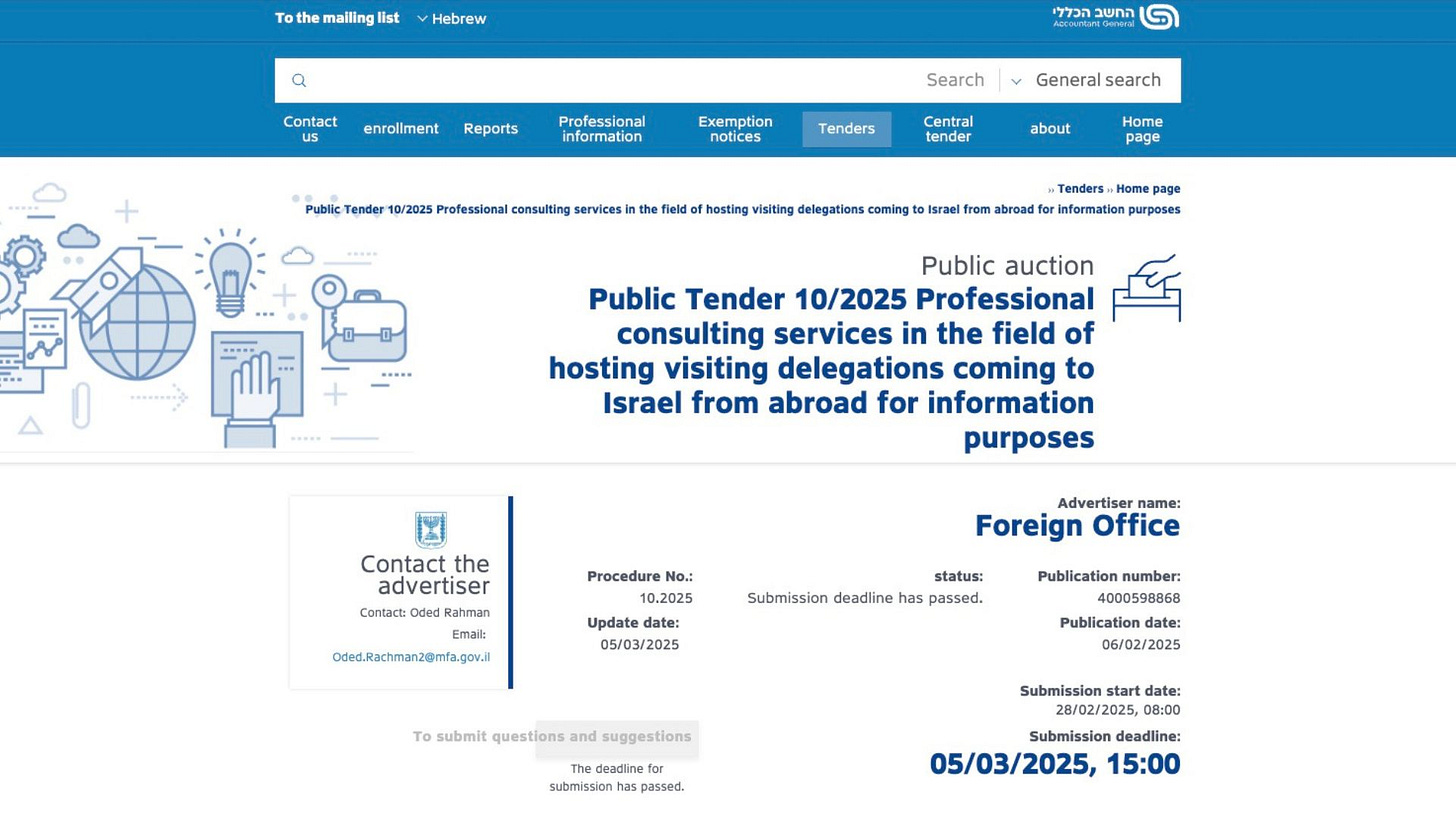
"The visitors will come from a wide array of fields, including culture, art, technology, economics, security, government, academia, education, tourism, and more," the official document from the MFA said.
The supplier was expected to help the ministry achieve its public diplomacy goals, improve foreign relations, and strengthen ties with "opinion leaders", and to also assist with post-visit follow-up and feedback to help Israeli missions abroad manage ongoing relationships and improve Israel's image globally.
The Israeli government has also courted pro-Trump MAGA influencers in a bid to boost support among Republicans who are increasingly divided over support for the war. In August, 15 high-profile influencers visited Israel on a trip organised by Israel365, an advocacy group that was awarded a no-bid contract worth $70,000 by the Israeli Foreign Ministry to organise the trip, Axios reported.
One of those on the trip, Jayne Zirkle, posted extensively about being on the "MAGA influencers" trip to Israel through Israel365, which included a visit to the occupied Golan Heights, the West Bank, and areas affected by the Hamas-led October 7 attack.
Other American personalities, including pro-Trump influencer Xaviaer DuRousseau, travelled inside Gaza in August. DuRousseau filmed himself in front of boxes of aid and said: "If I were Israel I wouldn't even provide matching socks to Gaza, but here's all the aid that y'all claim doesn't exist."
Pro-Israel media personality Brooke Goldstein, posting after an IDF-embed visit to view the work of the Gaza Humanitarian Foundation, said "what I saw proved that what the media is reporting about the situation is absolutely false"—despite a famine being declared three months into the GHF's operation.
Part II: Distribution through Israel's Foreign Affairs Ministry YouTube channel
On the surface, Israel's Foreign Affairs Ministry YouTube channel appears to be a conventional extension of state communication. It is a verified account that publishes press statements, cultural programming, and diplomatic messaging. With over 1,072 videos, nearly 100,000 subscribers, and activity dating back to December 2008, the channel presents itself as a tool of digital diplomacy—projecting Israel's image globally, well beyond the reach of traditional embassies and press offices.
However, beneath its official branding, the channel's activities reveal a deeper reality. It does not appear to be designed for steady audience growth or cultural exchange but rather for strategic bursts of visibility, financed directly through paid advertising campaigns. By opting out of monetisation, the ministry signals that its goal is not profit but influence. In fact, money flows in the opposite direction: instead of earning revenue, Israel pays Google to amplify its content.
In December 2024, Israeli Foreign Minister Gideon Sa'ar announced that his ministry would receive an additional $150 million (€128.3 million) on top of its existing budget for ongoing activities related to "public diplomacy." Sa'ar and his New Hope party agreed to rejoin Netanyahu's coalition in November in exchange for this funding and Sa'ar's appointment as foreign minister. At the time of the coalition agreement, Sa'ar indicated that the funding would be used to influence public sentiment in the foreign press and on social media.
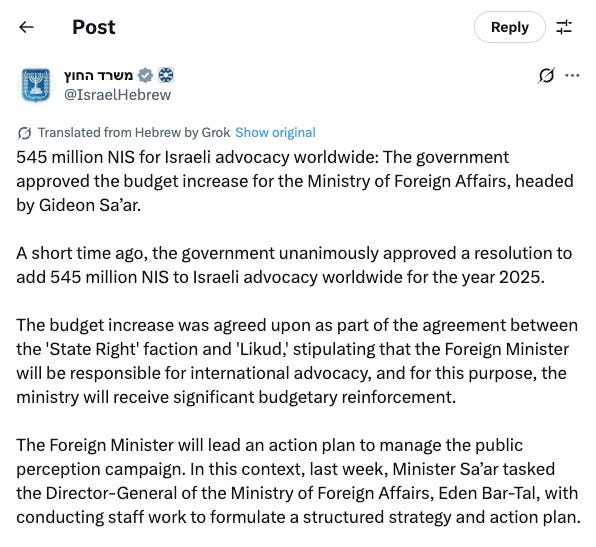
In a statement announcing the increase, Sa'ar said: "Israeli advocacy and the battle for public perception have not received the necessary resources and tools for decades for this campaign, which is critical and life-saving. I am determined to change this. Therefore, I insisted that a significant dedicated budget of 545 million Shekels be added to the Ministry of Foreign Affairs’ budget, designated for Israeli advocacy. I believe that every shekel allocated to this purpose is an investment, not an expense, and it will strengthen Israel and its standing in the world."
The channel makes use of tags, which help YouTube's algorithm understand its content, and this can influence where a channel's videos are displayed and to whom they are recommended. The channel uses tags such as "Israel", "humanitarian", "aid", "Palestine", "Palestinians", and "digitaldiplomacy".
Engagement spikes: Gaza as a paid campaign
On the same day that the initial IPC assessment was published, Lapam launched a new ad campaign featuring videos of food-filled markets and operational restaurants within the enclave.
Hosted on the Israeli Foreign Ministry YouTube channel, the videos included onscreen text and an AI-generated voiceover, concluding with the phrase: "There is food in Gaza. Any other claim is a lie." The restaurant videos were uploaded in multiple languages, including English, German, Italian, and Polish, while the market videos were posted in English, German, and Italian.
As part of this investigation, BR24, ORF, DW and VRT published detailed fact-checks on the content of the ads, which were misleading in their claim that food is plentiful in the Gaza Strip.
Footage shared by the Israeli Foreign Ministry on August 21 claims to show restaurants serving food to customers in July 2025. The video has been viewed more than six million times since its publication.
The multilingual rollout suggests that audience segmentation was intentional, aimed at influencing European and global perceptions of Gaza during a politically sensitive period. The seven videos were used as ads before YouTube videos and across Google products in Germany, Austria, the UK, Italy, and the U.S., and received a combined view count of close to 19 million.
Generally, these videos were reused multiple times for renewed paid ads between August 22 and the end of the month. Between August 5 and September 2, 2025, the account garnered over 30 million views in total.
Daily performance data from August 2025 shows significant traffic surges that coincide with the release of the videos about Gaza's restaurants and food markets.
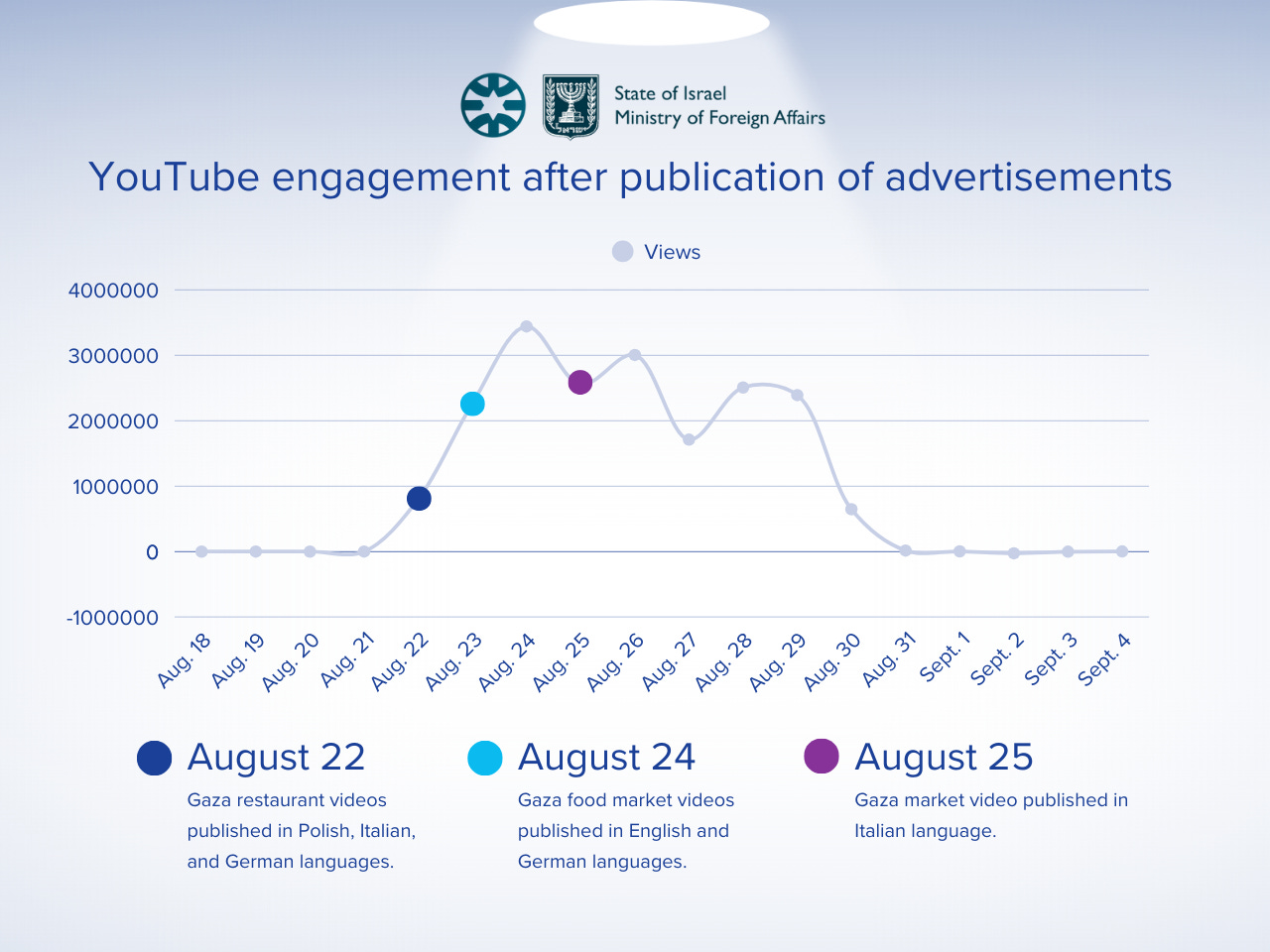
These were not organic hits. Analysis from Social Blade and platform tracking confirm that the videos were distributed through Google Ads, indicating that the Foreign Ministry deliberately paid to insert them into users’ feeds across multiple countries.
By early September, traffic collapsed, with some days showing negative views (–24,000 views on September 2). This reflects YouTube's purging of inflated or spam traffic, which is a common occurrence in large-scale ad campaigns.

Subscriber growth was modest: from 97,000 in early August to 99,300 by the end of the month, before plateauing. Despite millions of paid impressions, the campaign did not result in meaningful long-term audience growth.
This strategy carries far-reaching implications. By showcasing Gaza's restaurants and food markets, the ministry attempted to reframe the territory’s image from one of crisis to one of normalcy. YouTube and Google Ads have been the intermediaries and vehicles for delivering this content directly to the public. Without these globally dominant platforms and services, this level of exposure would be near impossible to achieve.
Examination of the Israeli Foreign Affairs Ministry's YouTube channel and subsequent statistics reveal that it operates as a state-sponsored advertising platform, flaring into prominence whenever political messaging is required and then fading into silence until the next campaign.
Part III: The strategy of hasbara
The documents outline a comprehensive communications strategy that adapts to both domestic and international needs.
At home, a cornerstone of this strategy is the "Daka LeShemona" (Minute to Eight) television segment. The segment, which is broadcast across all major Israeli channels directly before the evening news, is considered the most effective medium for delivering high-impact messaging. These one-minute TV segments are commissioned under exemption or tender, and cover topics including hasbara government communications.
Government documents repeatedly cite its "high viewership", "attention levels", and "effective messaging" as justification for its use. The unique nature of "Daka LeShemona" has allowed a single company, Grey Content Ltd., to become an indispensable partner for the government, as the company holds the exclusive rights to the slots. Some of the campaigns awarded to and carried out by Grey Content Ltd include:
The documents note that the production costs are typically less than 25% of the total contract value, a figure consistent with Lapam policy.
In each of these cases, the rationale provided by Lapam is the same: Grey Content's exclusive rights make it "impossible" to consider other options. Lapam also consistently approves the production component of the contracts, which is typically capped at less than 25% of the total value and less than 15% of the media cost, a policy decision that gives Grey Content a de-facto monopoly on both the airtime and the content.
This reliance on Grey Content is part of a broader trend in Israeli government contracting. These tenders and exemptions emphasise quality over price and require specific experience, notably security clearance. Government spending on public relations and information campaigns often uses emergency declarations and unique relationships to circumvent the public tender process. The documents show that even when the government is directed to find long-term solutions, it often continues to rely on these pre-existing, sole-source arrangements.
The Legal challenge
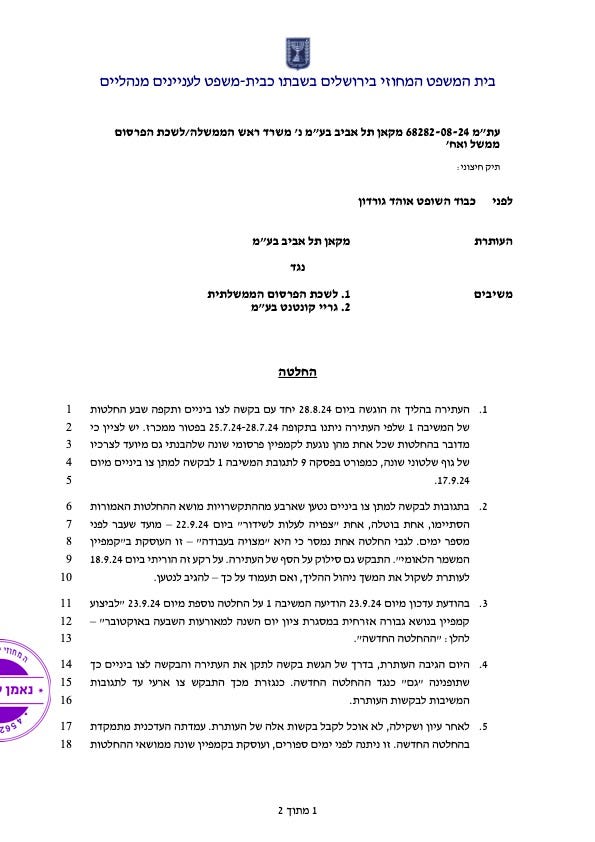
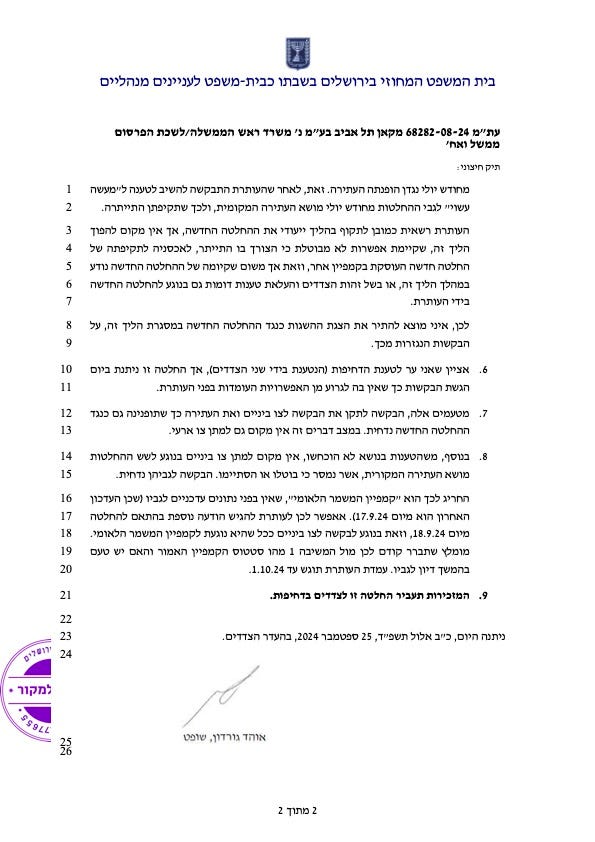
In August 2024, the Israeli advertising agency McCann Tel Aviv Ltd. filed a petition against the Israeli Prime Minister's Office, Lapam and Grey Content Ltd., along with a request for an interim injunction, against seven contracts awarded to Grey Content Ltd. between July 25, 2024, and July 28, 2024. These decisions, according to the petition, involved engagements granted with an exemption from tender for various advertising campaigns.
McCann Tel Aviv Ltd. requested that the court order the cancellation of these decisions, citing reasons such as damage to its rights and violation of tender laws, and the legitimacy of the "urgent" reasoning for the awarding of the exemption.
The court ultimately ruled against McCann Tel Aviv Ltd, saying it is ruling that the different campaign production had already begun, involving significant public funds, and halting it would cause substantial damage.
Despite the court's decision, the case indicates that other major advertising and media firms are challenging the legality of these direct, no-bid contracts.
The spokesperson cadre: ‘Special trust’
For foreign media, the documents highlight an urgent need for a cadre of professional spokespeople, or Masbiranim. A publication from September 2024 detailed the engagement of eight English and Farsi-speaking spokespeople. This was done via a tender exemption, with the National Public Diplomacy Directorate citing an "urgent need to prevent significant damage to Israel's public relations efforts on the global stage."
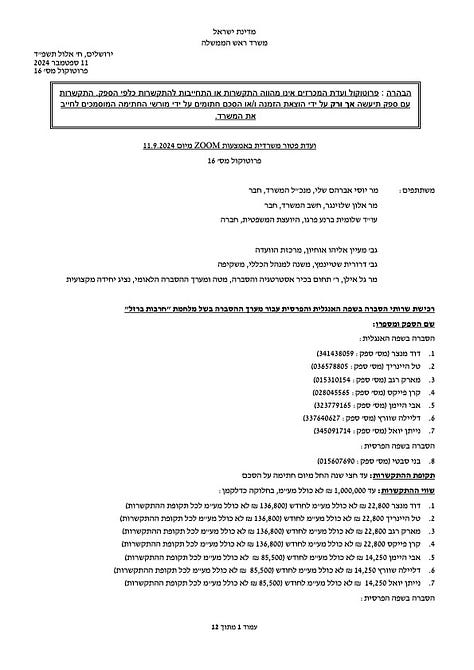
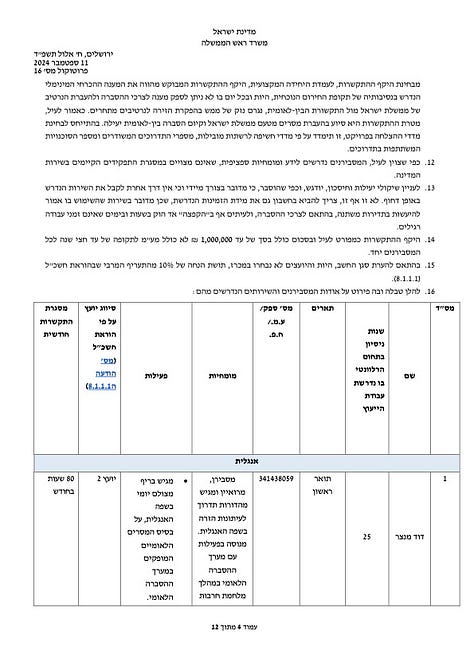
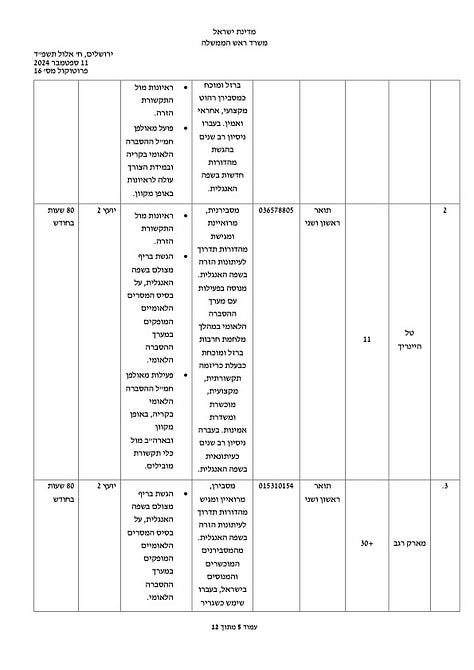
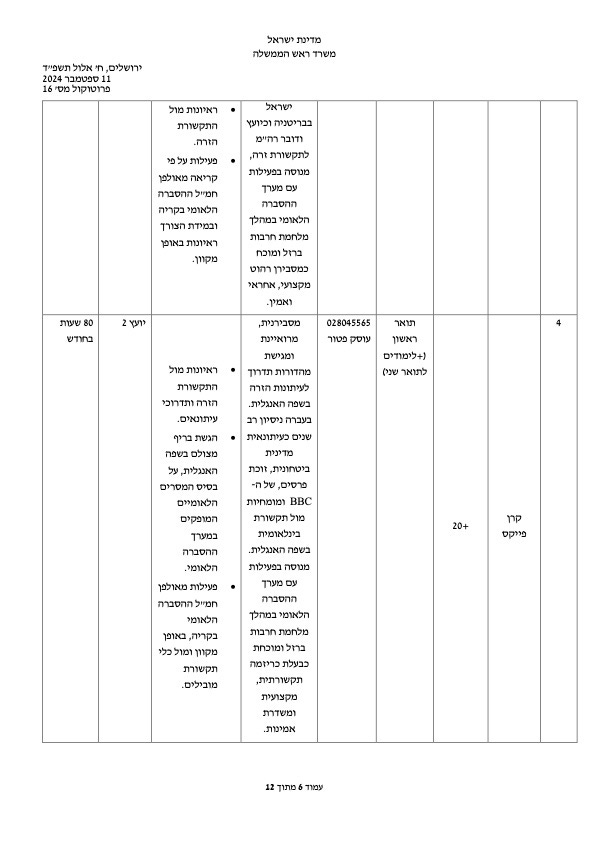
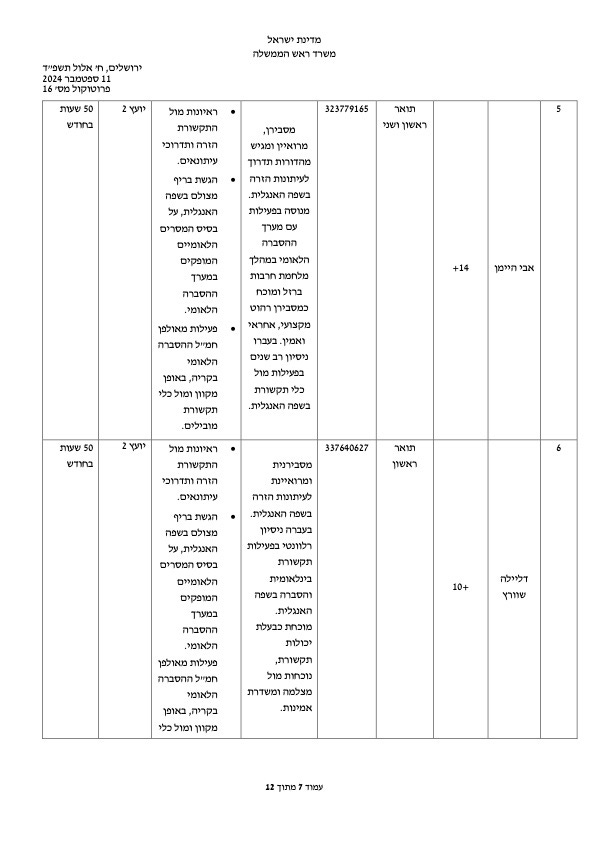
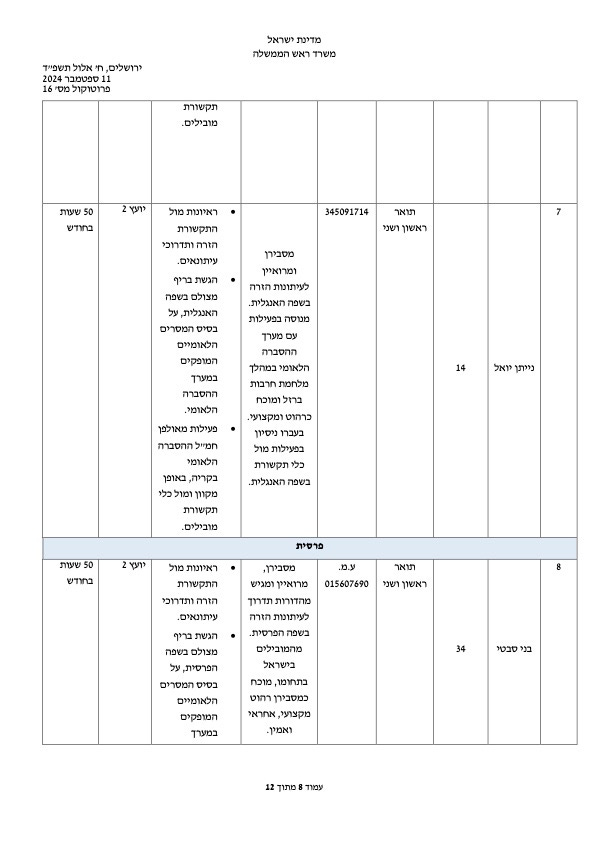
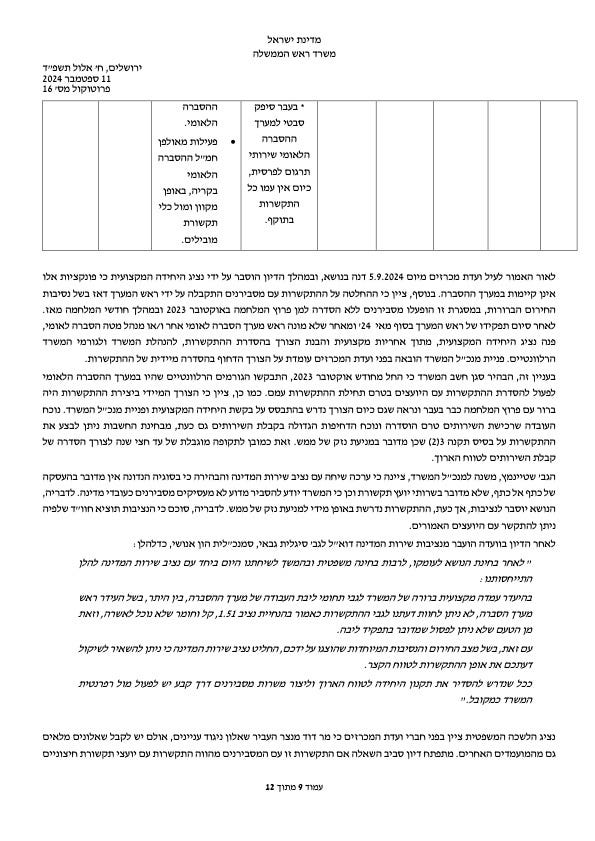
The documents explicitly state that the "lack of spokespersons... causes significant damage to the effort to preserve the legitimacy of Israel's actions," arguing that the failure to counter competing narratives in the international arena was a severe detriment.
The contracts for these services were not awarded through a public bidding process. Instead, they were justified by Regulation 5(a)(2)—which allows for an exemption from a tender process for work requiring "special trust relationships".
The documents state that a key figure like Israeli government spokesman David Mencer, for example, possesses a "deep knowledge" of the issues and a "proven ability to convey sensitive messages accurately".
An evolving, high-value contract
Mencer was among a group of eight "public diplomacy specialists" identified by the government to fulfil contracts as a temporary measure during the “Iron Swords War,” the name given by Israel to its military operation in Gaza that began in response to the Hamas-led attacks on October 7, 2023.
The initial contract, approved in September 2024, was set for up to six months and had a total value of up to 1,000,000 Shekels (approximately €256,000) for all eight consultants. Due to various issues, including insurance difficulties, Mencer's contract was the only one ultimately executed from this initial group, the documents show.
A subsequent extension was approved in May 2025, for up to one year, or until a maximum budget of 127,118 Shekels (€32,600) was reached. The hourly rate was set at 285 Shekels (€73), with a monthly cap of 80 hours.
A more significant shift occurred a month later, when the contract was reclassified to be under Regulation 5(a)(2), with the Prime Minister's Office justifying this change by citing the "deep trust" that had developed between the Prime Minister and Mencer, as well as his "unique expertise" and long experience in communications.
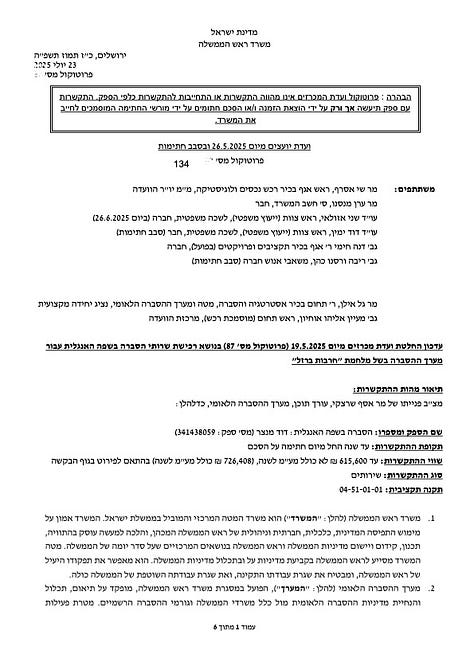
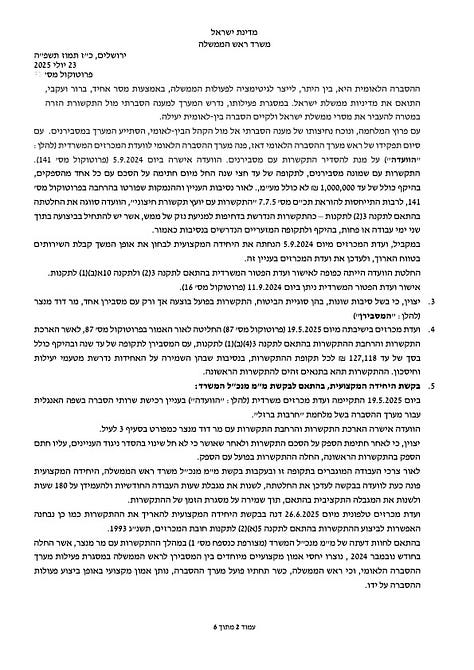
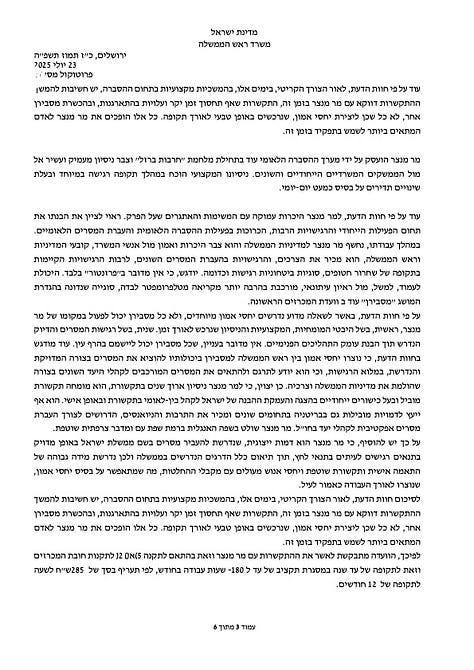
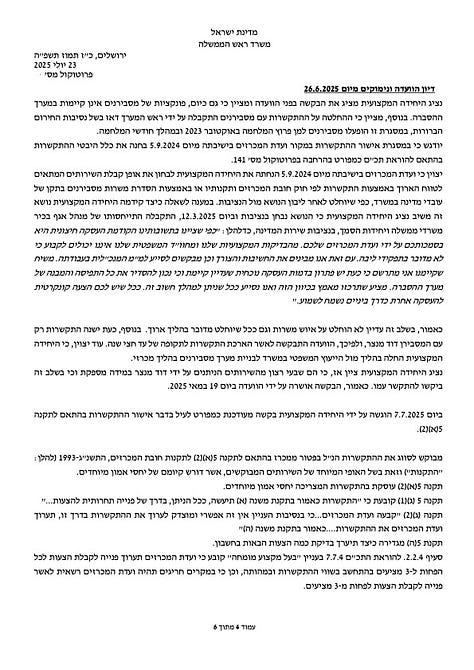
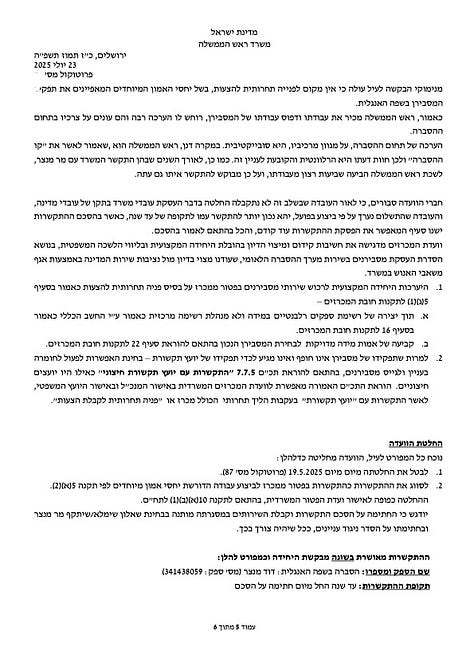
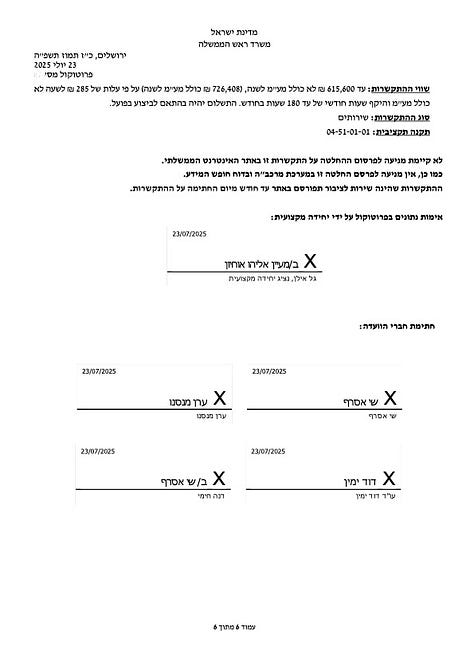
This new contract, which superseded the previous agreement, increased the potential monthly work hours to 180 and raised the total value to up to 615,600 Shekels (approximately €157,700) for a period of up to one year, with payment based on actual hours worked.
Despite directives from the exemption committee to find a more permanent, long-term solution, the PMO approved the extension based on the premise that an urgent need still existed for his specific skills.
Mr. Mencer did not respond to requests for comment on this investigation.
Part IV: Procurement as a weapon
The procurement process itself is a key part of the story, revealing the strategic mindset of the government. Committee approvals from various ministries, including the Ministry of Foreign Affairs, Ministry of Justice, and Ministry of Tourism, demonstrate a consistent pattern of bypassing or extending standard procedures. The justifications for these tender exemptions are varied but recurring.
The "Iron Swords War" is cited in dozens of documents to justify immediate, non-tendered procurements. The Ministry of Health, for example, rapidly engaged Graphos Print Ltd. to produce roll-ups for displaced persons, escalating a minor contract from 19,824 Shekels (€5,000) to over 79,000 Shekels (€20,000) in a matter of days due to the "urgent need."
In June, an Israeli Exemption Committee approved an application by Lapam to engage with Google, X, and French and Israeli advertising platforms Outbrain/Teads, to run public information campaigns worth 167 million Shekels (€42.8 million), according to the translated official document.
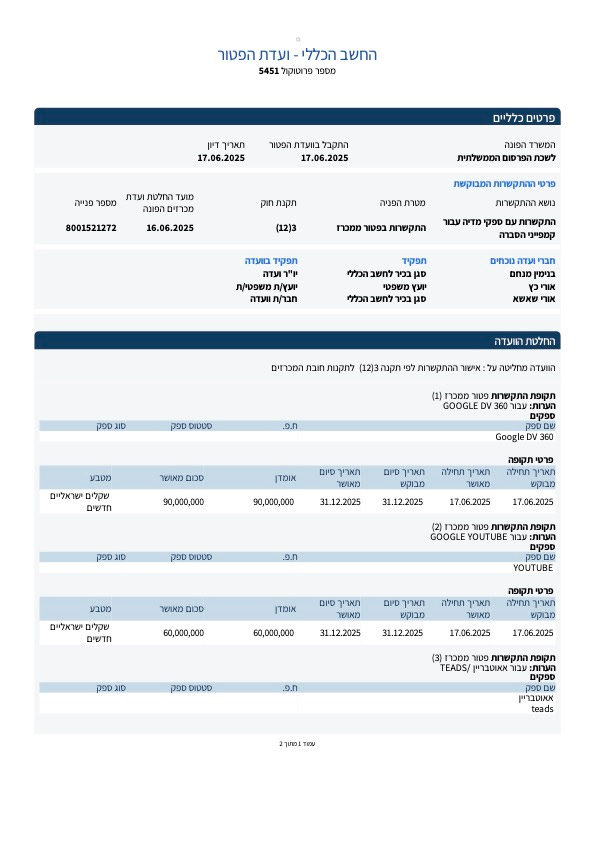
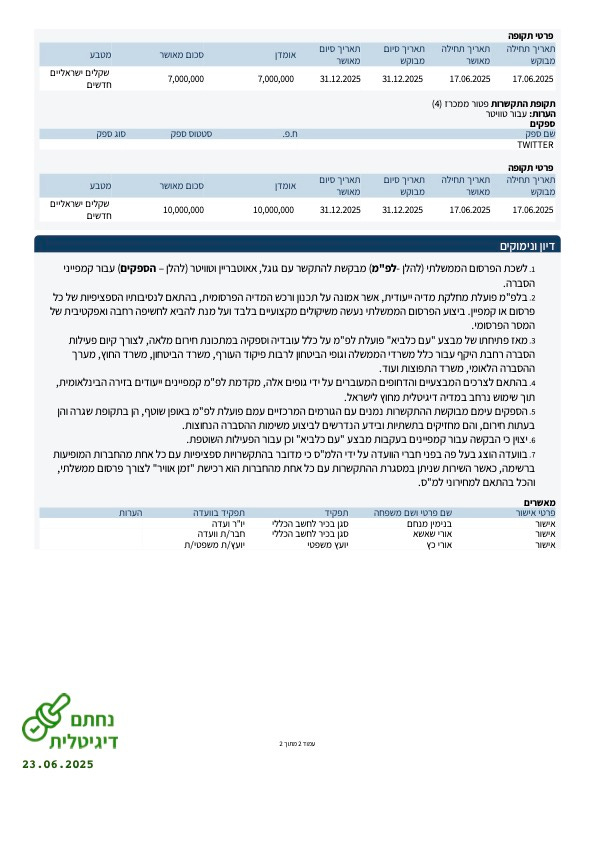
The approved contracts, set to run from June 17 until December 31, 2025, saw 150 million Shekels (approximately €38.5 million) allocated to YouTube and Google's advertising campaign management platform, Display & Video 360, while a further 10 million Shekels (€2.56 million) was approved for campaigns on X. French and Israeli advertising platforms Outbrain/Teads were slated to receive seven million Shekels (€1.79 million).
"The request is for campaigns related to 'Operation Rising Lion' (Israel's military offensive in Iran) as well as ongoing activities. The committee was told that these are specific engagements with each company to purchase ‘airtime’ for government advertising, based on L'PAM's price lists," the document states.
As with Grey Content Ltd., direct engagements have been made with exclusive service providers, such as WOCHIT, an Israeli-founded cloud-based video creation platform that enables users to produce high-quality videos in over 20 languages.
Several documents detail the exercise of “options for extension” with existing suppliers to maintain service continuity while a new tender process is underway. This practice, while regulated, shows a clear preference for proven relationships over a new, potentially disruptive, competitive process.
Part V: Targeting critics and countering narratives
The documents show that the hasbara efforts are not only about promoting a positive image, but also about actively discrediting and undermining critics. The government of Israel has long utilised its advertising agency to fund paid international campaigns aimed at European and North American audiences.
For over a year, government-funded ads have appeared as top search results for "UNRWA," directing users to a government website that accuses the agency of being a "front for Hamas." These ads, with slogans like "Paychecks for terrorists or humanitarian aid?", have been denounced by the UN as "hate speech" and "disinformation."
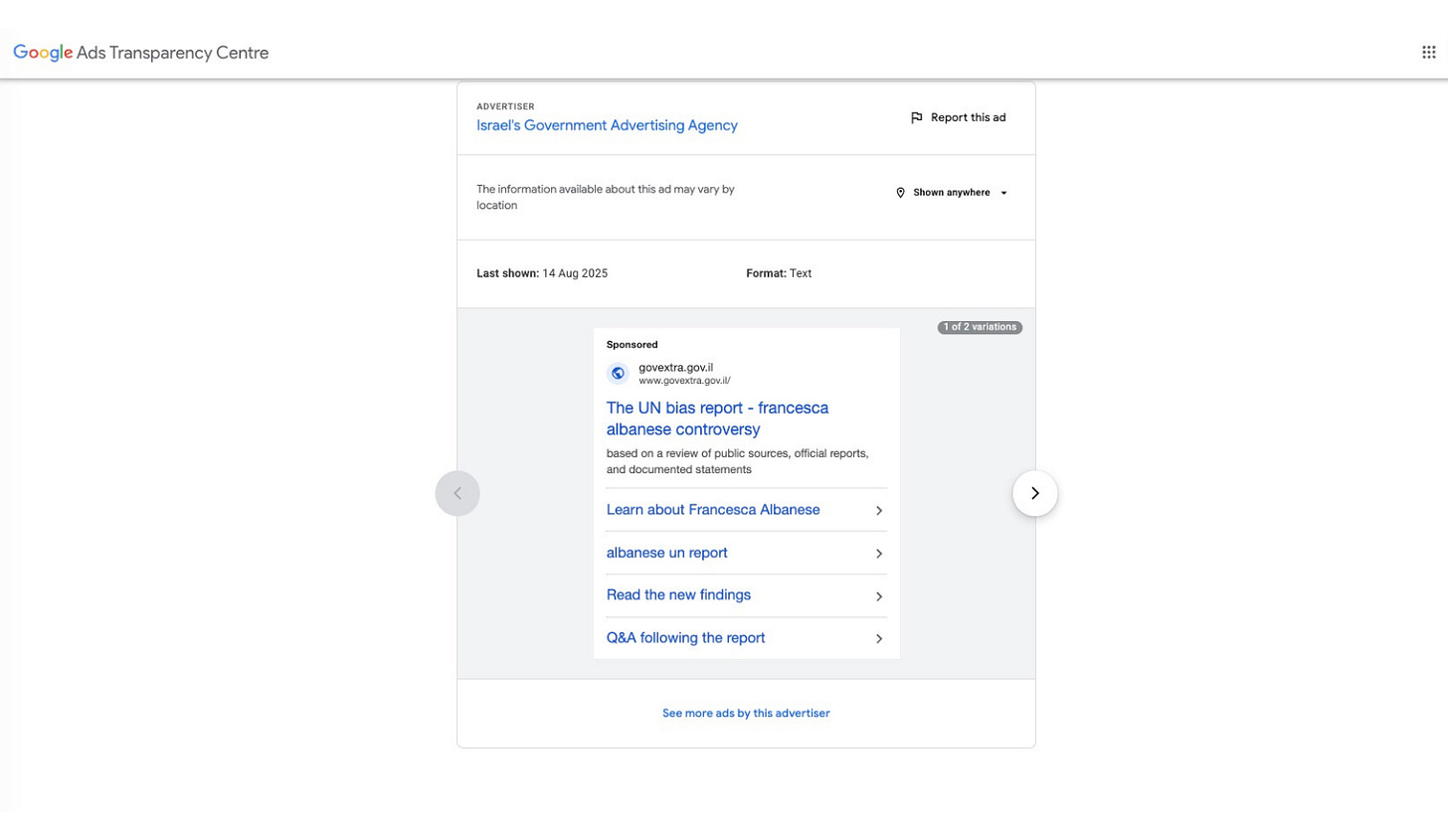
The UN Special Rapporteur on the Occupied Palestinian Territories, Francesca Albanese, has been the subject of a months-long counter-campaign. Paid-for ads across Europe have accused her of being an "anti-Semite" for her public criticism of Israeli policies. Google's mislabelling of these ads under mild categories like "Family and Community" has, in some cases, helped them bypass political advertising restrictions.
Tommaso Canetta, Fact-checking Coordinator at the European Digital Media Observatory, noted that maintaining the support of Europe and the United States is a key priority for the Israeli government as it tries to stave off the type of international isolation South Africa faced near the end of the Apartheid era.
"I think the general idea behind the Israeli propaganda and disinformation is to win the sympathy of the Western public opinions in Europe, of course, also in the United States. Israel is now facing an unprecedented risk of isolation from the international community...This is a clearly a strategic interest for them. The war, you can fight it in the field, but also in the information ecosystem. And in the information ecosystem, their strategic goal is not to be isolated, not to lose the support of the Western of the European public opinions."
Oren Persico, an Israeli journalist at investigative outlet The Seventh Eye, said a focus on overly specific cases, such as a restaurant open in Gaza or food at a market filmed on one day, is a method to move attention away from the bigger picture.
Persico said the planting of government "spin and messages" abroad is part of the Israeli strategy, in part because it doesn't need to do much narrative-building at home.
"Abroad, in France, Germany, wherever, they would show, I presume, what's going on in Gaza, and maybe a comment or a response from the Israeli government at the end. The main thing wouldn't be the narrative of the Israeli government. And so Israel does try to spread its hasbara through YouTube channels or Facebook, Twitter, whatever. In Israel, you don't really need that."
Hasbara, a Hebrew word meaning 'explanation' that is most often used to describe the communications strategy for the state narrative, is actually a topic of much discourse in Israel, according to Persico.
“One of the main talking points in Israel these days is the lack of effective Israeli hasbara. Somehow, the Israelis believe that if only they could put their message out, the world would understand that we are the victims. And if you look at the history of Israeli hasbara, you see that after every atrocity this sort of public discussion re-emerges. 'Why don't we have enough funding? Why don't we have enough people working on hasbara?'“
The stakes of the digital battlefield
The documents lay bare the full extent of a strategic, well-funded, and deeply integrated information operation. By leveraging the legal flexibility of its procurement system and the technological reach of global digital platforms, Israel has created an agile apparatus for public diplomacy.
It is not the only side of this conflict using pictures to portray a certain image of the situation. Although less frequent in its media releases, Hamas has published videos online, including two clips showing a starving hostage. These propaganda efforts are far less wide-reaching and effective, as online channels for Hamas are blocked in much of Europe under terrorism laws, and in many cases can only be seen via news reporting on the videos or third party reshares on social media.
Eurovision News Spotlight contacted Google on two occasions for comment regarding its policies surrounding misinformation and advertising standards, safeguards against the proliferation of state-generated propaganda, and the substantial amount of money being spent by the Israeli government on advertising on the platform. Google failed to respond to both requests.
Israel's strategy highlights the vulnerability of the international public to emotionally persuasive narratives and the challenges faced by fact-checkers and traditional journalists in countering them.
As Tommaso Canetta noted, Israel’s goal is to avert international isolation and "win the sympathy of Western public opinions".
The battle for hearts and minds is now a key part of modern conflict. The documents show that Israel has chosen to wage this war on the digital front, using sponsored ads as a powerful tool in its arsenal. And in this new digital arena, the cost of the campaign, measured in millions of shekels, is considered a necessary expense for national security.
Reporting by Max Gilbert (BR24), Michael Schlegel (BR24), Jana Heigl (BR24), Eva Wackenreuther (ORF defacto), Kathrin Wesolowski (Deutsche Welle), Alima de Graaf (Deutsche Welle), Daan Nicolay (VRT), Maria Flannery (EBU) and Derek Bowler (EBU) for Eurovision News Spotlight.
Further reading as part of this investigation:
BR24: How Israel's government deliberately sows doubts about famine in Gaza
Deutsche Welle: Israel spends vast sums on propaganda ads
VRT: Israel pays millions to Google for YouTube ads denying famine in Gaza
RTVE: Israel pays for a multi-million dollar Google ad campaign to deny the famine in Gaza
SOURCES
Social Blade. (2025). Available at: Israel’s Foreign Affairs Min.'s YouTube Statistics. [online] [Accessed 4 Sep. 2025].
Monir Ghaedi (2025). Fact check: Netanyahu’s disinformation about famine in Gaza. [online] dw.com. Available at: https://www.dw.com/en/fact-check-aid-groups-contradict-israeli-gaza-claims/a-73456462 [Accessed 4 Sep. 2025].
Ashraf, A. (2025). Fact check: Gaza famine photos not staged. [online] dw.com. Available at: https://www.dw.com/en/fact-check-gaza-famine-photos-not-staged/a-73626929 [Accessed 4 Sep. 2025].
X (formerly Twitter). (2025). Available at: "No preliminary explanatory activity was prepared" [Accessed 4 Sep. 2025].
gov.il. (2025). Available at: Ministry of Foreign Affairs [Accessed 4 Sep. 2025].
Youtube.com. (2025). Available at: Footage of food scene in Gaza city, July 2025 [Accessed 4 Sep. 2025].
Youtube.com. (2025). Available at: Riprese reali dei mercati alimentari di GazaLuglio-Agosto 2025 [Accessed 4 Sep. 2025].
Youtube.com. (2025). Available at: Echte Aufnahmen von Lebensmittelmärkten in Gaza, Juli-August 2025 [Accessed 4 Sep. 2025].
Youtube.com. (2025). Available at: Materiał filmowy przestawiający restauracje w mieście Gaza Lipiec 2025 [Accessed 4 Sep. 2025].
Facebook.com. (2019). Facebook. [online] Available at: The distinctive taste just became clearer [Accessed 4 Sep. 2025].
Google Maps: (2021). Available at: 31°31'13.7"N 34°26'36.6"E [online] [Accessed 4 Sep. 2025].
Nordic Editor (2024). Available at: Sweden: UNRWA accuses Israel of hate speech in ads. [online] United Nations Western Europe. [Accessed 4 Sep. 2025].
Timesofisrael.com. (2025). Anyone in Gaza City who doesn’t evacuate ‘can die of hunger or surrender,’ Smotrich said to tell IDF chief. [online] [Accessed 4 Sep. 2025].
Timesofisrael.com. (2025). Far-right minister says Israel should bomb humanitarian aid, ‘starve’ Gazans. [online] [Accessed 4 Sep. 2025].
MDA. (2025). Available at: The Connection Between UNRWA and Hamas in Gaza. [online] Available at: [Accessed 4 Sep. 2025].
Kingsley, P. and Reiss, J. (2025). As Starvation Rises, Israeli Minister Says Israel Is ‘Driving Out’ Gazans. [online] Nytimes.com. [Accessed 4 Sep. 2025].
Google.com. (2019). Available at: CPM ads - Google AdSense Help. [online] [Accessed 4 Sep. 2025].
Integrated Food Security Phase Classification (IPC). Famine Review Committee: Gaza Strip, August 2025: Conclusions and Recommendations.
Youtube.com. (2025). @IsraelMFA [Accessed 4 Sep. 2025].
Integrated Food Security Phase Classification (IPC). Fact Sheet: The IPC Famine. [Last update: August 2025].
Integrated Food Security Phase Classification (IPC). Response to Issues Raised Following IPC's Famine Classification in the Gaza Strip. [August 30, 2025.]
Google.com. (2019). Available at: Don't be fooled by HRF's mask - HRF's disturbing reality [Accessed 4 Sep. 2025].
Youtube.com. (2025). Available at: THE UN Refuses To Distribute Aid To Gaza [Accessed 4 Sep. 2025].
Team, Ytl. (2025). Available at: Youtube Tag Extractor. [online] YTLarge. [Accessed 4 Sep. 2025].
Linkedin.com. (2025). LinkedIn. [online] Available at: Tommaso Canetta [Accessed 4 Sep. 2025].
Edmo.eu. (2025). Available at: EDMOeu Team – EDMO. [online] [Accessed 4 Sep. 2025].
lapam.gov.il. (2025). Available at: Israel Government Advertising Agency [Accessed 4 Sep. 2025].
MDA. (2025). Available at: Francesca Albanese: Violations of UN Ethics and Impartiality. [online] [Accessed 4 Sep. 2025].
Google.com. (2019). Available at: United nation - UHRC - The human rights circus show [Accessed 4 Sep. 2025].
Bowler, D. and Flannery, M. (2025). Available at: Israeli government agency paid for adverts targeting Eurovision Song Contest public vote. [online] Spotlight.ebu.ch. [Accessed 4 Sep. 2025].
Google.com. (2019). Available at: UN Agencies Bias Uncovered [Accessed 4 Sep. 2025].
Linkedin.com. (2025). LinkedIn. [online] Available at: David Kriegleder [Accessed 4 Sep. 2025].
UN Watch. (2025). Available at: UN Watch Refutes Biased New Report by Francesca Albanese - UN Watch. [online] [Accessed 4 Sep. 2025].
Instagram. (2017). Stella Inger-Escobedo on Instagram: ‘This is a restaurant in North Gaza - posted one day ago. Famine ? @manakish_restaurant’. [online] [Accessed 4 Sep. 2025].
Team, Ytl. (2025). Available at: YouTube Channel Monetization Checker. [online] YTLarge. [Accessed 4 Sep. 2025].
Instagram. (2017). Pistachio on Instagram: "People of taste and Pistachio lovers..." [online] [Accessed 4 Sep. 2025].
Instagram. (2017). Pistachio on Instagram: "Welcome back! We are pleased to announce that Pistachio is back in business". [online] [Accessed 4 Sep. 2025].
Instagram. (2017). Majdi Fathi on Instagram: ‘A palestinaine mother holds her child who suffer from malnutrion while she brought him to the Patient Friends Association Hospital in Gaza City on July 22, 2025. photo by majdi fathi’. [online] [Accessed 4 Sep. 2025].
UN News. (2025). Gaza: More than a million receive food aid since the start of the ceasefire. [online] [Accessed 4 Sep. 2025].
Youtube.com. (2025). Available at: 'Hamas turns Gaza into a propaganda set'. [Accessed 5 Sep. 2025].
X (formerly Twitter). (2025). Available at: 'Desde shawarma hasta mariscos, la escena gastronómica de Gaza City prospera este julio.' [Accessed 5 Sep. 2025].
X (formerly Twitter). (2025). Available at: 545 million NIS for Israeli advocacy worldwide [Accessed 5 Sep. 2025].
Axelrod, T. (2025). Israel courts MAGA influencers amid Gaza backlash. [online] Axios. [Accessed 8 Sep. 2025].
X (formerly Twitter). (2025). Available at: Welcome to THE BORDER between Israel and Syria in the Golan Heights... [Accessed 8 Sep. 2025].
X (formerly Twitter). (2025). Available at: Nova Music Festival October 7th Memorial [Accessed 8 Sep. 2025].
X (formerly Twitter). (2025). Available at: Today Israel 365 brought a group of MAGA influencers to the West Bank [Accessed 8 Sep. 2025].
Govextra.gov.il / MDA. (2025). Politics Disguised as Science: The Credibility Crisis of IPC ‘Famine’ Analyses in Gaza. [online] [Accessed 8 Sep. 2025].
Instagram. (2017). Xaviaer DuRousseau 𓀀 on Instagram: ‘Go to Gaza? BET… WALK WITH ME.’ [online] [Accessed 8 Sep. 2025].
Instagram. (2017). Brooke Goldstein on Instagram: ‘This week I entered Gaza with the Gaza Humanitarian Foundation. I am one of the only civilians who has been given permission to enter...' [Accessed 8 Sep. 2025].
X (formerly Twitter). (2025). Available at: The IPC has just published a “tailor-made” fabricated report to fit Hamas’s fake campaign. [Accessed 8 Sep. 2025].
X (formerly Twitter). (2025). Available at: The statement of the International Association of Genocide Scholars (IAGS) is an embarrassment to the legal profession and to any academic standard. [Accessed 8 Sep. 2025].
Echtermann, A. (2025). Israel verbreitet Falschinformation über Hungersnot-Bericht. [online] tagesschau.de. [Accessed 12 Sep. 2025].







